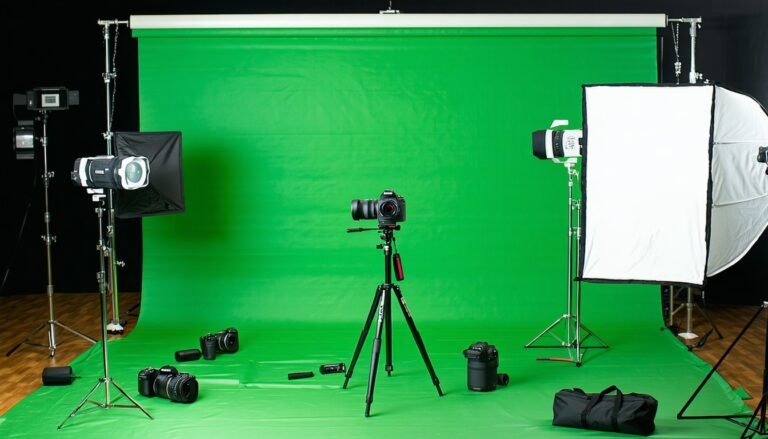Mastering a green screen lighting setup is one of the most effective ways to elevate your compositing and impress your audience. A properly lit green screen lets you pull clean keys, retain natural-looking edges, and minimize the dreaded neon “spill” effect that instantly screams “fake.” If you’ve ever walked away from a shoot wondering why your actor looks radioactive, you’re not alone. Let’s break down how to avoid common pitfalls and set up a green screen that behaves itself in post.
Plan your green screen lighting.
Before you flip on the first light or roll the camera, take some time to plan. The goal is to create an even wash of light across your backdrop with minimal hot spots or shadows.
- Keep it flat: Position your lights so they hit the screen as evenly as possible. Dim or reposition any lights that are creating bright patches.
- Watch for wrinkles: Wrinkles, seams, or any texture on the screen can throw unwanted shadows. Stretch or clamp your backdrop to keep it smooth.
- Distance matters: The closer your subject is to the background, the more green will reflect onto them. Leaving a few feet of space can dramatically reduce the risk of spills.
Balancing your setup here saves you hours in post-production. If you’re curious about the advanced extraction process, check out this professional keying techniques resource for deeper insights.
Place your lights effectively.
With your green screen in place, it’s time to focus on lighting your talent. You want them to look good without accidentally washing the background with extra light.
- Use separate light clusters: Dedicate one set of lights purely to illuminate the green screen, and another set to light your subject. That way, you can control each layer without interfering with the others.
- Go for soft, even subject lighting: A softbox or diffusion panel helps eliminate harsh shadows on your actor’s face. Aim for consistent coverage rather than dramatic modeling, so the keying process remains straightforward.
- Experiment with angles: Often, placing lights at a 45-degree angle on either side of the subject creates a pleasing fill. Move them around slowly until you find the sweet spot that separates the subject from the background.
The right lighting strategy will keep your base footage flexible. When you’re ready to blend everything, check out our green screen compositing tutorial to see how lighting ties into the complete compositing workflow.
Control the spill to maintain a clean key.s
Even with perfect coverage, a green or blue spill can creep onto hair, reflective surfaces, or clothing. That’s when people notice, “Oh… that’s green screen.”
- Flag and filter: Use flags, barn doors, or black foam boards to block any stray light that bounces off your screen and onto your subject.
- Increase distance: The further you can move your talent from the backdrop, the less spill you’ll deal with.
- Keep an eye on your wardrobe: Shiny fabrics reflect more color. A quick wardrobe tweak might be all you need to dial back unwanted green tints.
If you’re planning to use software like After Effects to refine your work, consider taking a look at ‘Keying out green screen in After Effects’ for a detailed walkthrough. This can help you push those edges to pro-level quality.
Refine your final composite.
After you’ve shot your footage with a reliable green screen lighting setup, you’ll transition to the compositing phase. Here, details matter.
- Evaluate your channels: Switch your view to a matte display if your software allows it, so you can see exactly where your key is clean and where it’s struggling.
- Tweak the edges: Adjust clip white and clip black settings to tighten up any soft edges or remove leftover green haze.
- Suppress spill: If you still see green around hair or reflective surfaces, most keying tools have straightforward controls to neutralize it. Just be gentle, so you don’t obliterate natural color.
If you need advice on selecting the right tool for your workflow, here’s a quick overview of some of the best green screen keying software.
Wrap up your project
Congratulations, you’ve set up your green screen, lit your subject, and refined your final composite. Now you can seamlessly integrate your footage into any background, whether you’re creating a futuristic cityscape or simply removing an unwanted alleyway.
Remember:
- Even lighting on both the screen and your talent is crucial.
- Separate your subject lights from your backdrop lights.
- Controspillsl by using distance, flags, and mindful wardrobe choices.
- Polish in post with careful key adjustments and spill suppression.
A solid foundation in lighting ensures that what you do in post is mostly fine-tuning, not a rescue mission. If you’re ready to take your keying skills to the next level, you might explore more advanced techniques in professional keying. With a well-planned green screen lighting setup, you’re free to bring any scene, imaginary or otherwise, into your frame. Now get out there and make some movie magic!
FAQS – Frequently Asked Questions
1. What Is the Importance of a Proper Green Screen Lighting Setup?
A proper green screen lighting setup ensures even chroma keying, prevents shadows, and reduces post-production cleanup for seamless compositing.
2. Why Should the Green Screen Be Lit Separately From the Subject?
Lighting the green screen separately in a green screen lighting setup prevents green spill on the subject and enhances keying accuracy.
3. What Type of Lights Are Best for a Green Screen Lighting Setup?
Soft, diffused LED or fluorescent lights are best for a green screen lighting setup to avoid harsh shadows and achieve even illumination.
4. How Do You Eliminate Shadows in a Green Screen Lighting Setup?
Positioning soft lights evenly across the green screen and maintaining proper subject distance helps eliminate shadows in a green screen lighting setup.
5. Can You Use Natural Light for a Green Screen Lighting Setup?
While natural light can work, it is unpredictable. A controlled artificial green screen lighting setup is preferred for consistency and accuracy.
6. How Far Should the Subject Be From the Green Screen?
In a green screen lighting setup, the subject should stand 6–10 feet away to minimize green spill and ensure clean separation from the background.
7. Is Backlighting Necessary in a Green Screen Lighting Setup?
Yes, backlighting (rim light) in a green screen lighting setup helps create depth and separates the subject from the green background.
8. What Is Green Spill and How Does Lighting Affect It?
Green spill is the reflection of green light on the subject. A well-balanced green screen lighting setup minimizes spill and reduces post-editing work.
9. Should You Use Gels in a Green Screen Lighting Setup?
Gels are generally not needed in a standard green screen lighting setup but may be used for creative subject lighting without affecting the green screen.
10. How Does Background Wrinkle Impact a Green Screen Lighting Setup?
Wrinkles cast shadows and make chroma keying harder. A smooth, taut background is essential in a green screen lighting setup.
11. What’s the Ideal Color Temperature for a Green Screen Lighting Setup?
Use daylight-balanced lighting (around 5600K) in your green screen lighting setup to maintain consistency across scenes.
12. Can Ring Lights Be Used in a Green Screen Lighting Setup?
Ring lights are not ideal for evenly lighting the green screen but can be used on the subject in a green screen lighting setup if properly controlled.
13. Is Three-Point Lighting Effective for Green Screen Shoots?
Yes, combining three-point lighting for the subject with separate background lights creates a professional green screen lighting setup.
14. How to Avoid Hotspots in Green Screen Lighting?
Evenly distribute soft lights across the screen and monitor exposure to avoid hotspots in your green screen lighting setup.
15. Does the Size of the Green Screen Affect the Lighting Setup?
Larger screens require more lights to maintain uniform brightness in a green screen lighting setup, especially on wide shots.
16. What Is the Role of Softboxes in a Green Screen Lighting Setup?
Softboxes diffuse light, helping create an even, shadow-free green screen lighting setup essential for clean keying.
17. How Do You Light a Green Screen Outdoors?
Use reflectors and diffusion panels to balance sunlight and control shadows in an outdoor green screen lighting setup.
18. Can Poor Lighting Be Fixed in Post-Production?
Poor green screen lighting setup can be corrected to some extent in post, but it’s always better to get clean footage on set.
19. What Is a Key Light’s Role in a Green Screen Lighting Setup?
The key light illuminates the subject, and should be controlled to avoid casting shadows on the green screen during your lighting setup.
20. How Much Light Intensity Is Needed for Green Screens?
Enough intensity to achieve even exposure without overexposing. A light meter helps measure this in a green screen lighting setup.
21. How Can You Test a Green Screen Lighting Setup Before Shooting?
Record test footage and use chroma keying in your editing software to identify uneven lighting or green spill in your green screen lighting setup.













